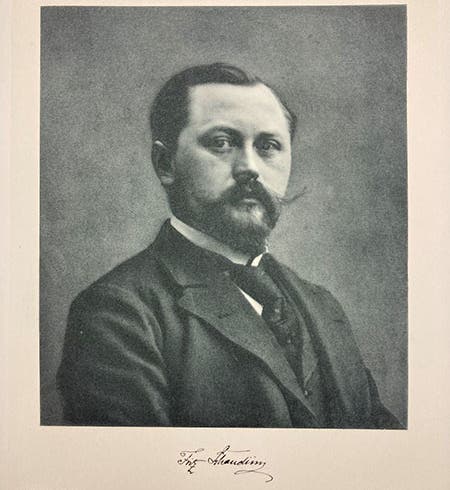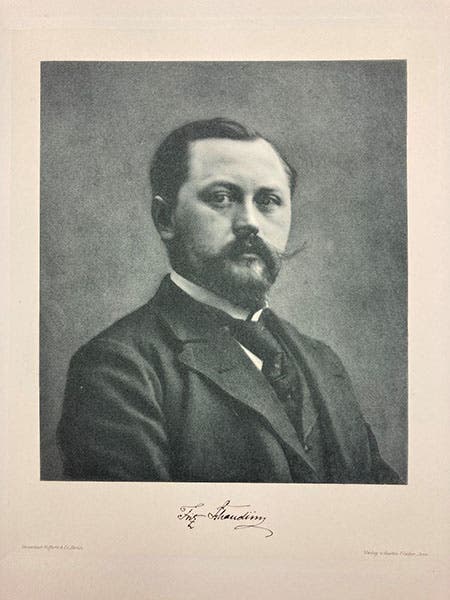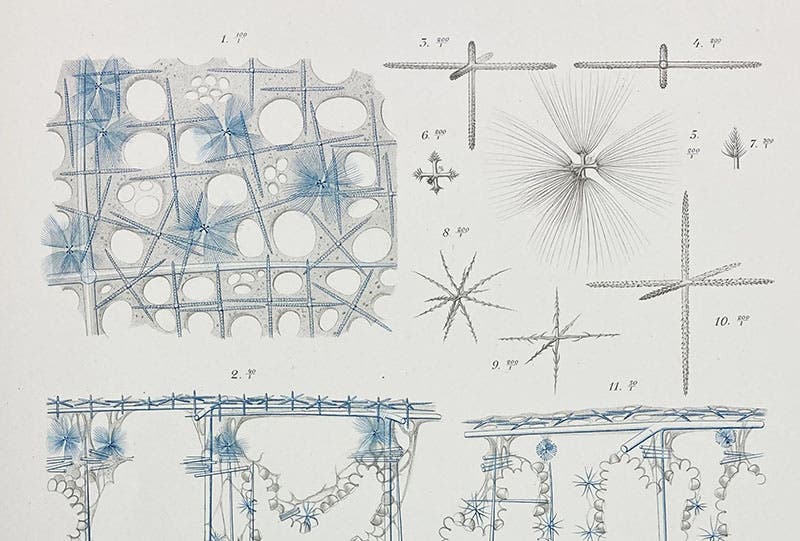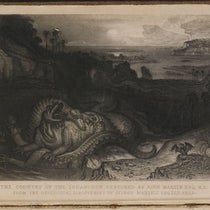Scientist of the Day - Fritz Schaudinn
Fritz Schaudinn, a German zoologist, died on June 22, 1906. Schaudinn was a pioneer protozoologist, attending to the study of very small animal life, such as amoebas. The role of protozoa in human disease was just beginning to be understood at the end of the 19th century, partially because of the development of the Zeiss microscope and of staining techniques that made it possible to see and identify some of these tiny creatures, and more importantly, to tell them apart. For example, there is an amoeba, Entamoeba coli, that is found in all humans, including healthy ones, but Schaudinn discovered that a related species, Entamoeba histolytica, is found only in people with dysentery and is most likely the cause of the disease (and which is now called amoebic dysentery).
Schaudinn's most famous pathogen discovery was Treponema pallidum, the tiny spirochaete that causes syphilis. Syphilis had been a scourge for 400 years and no one could identify the causative agent. In 1905, Schaudinn (with his coworker Erich Hoffmann) was able to distinguish Treponema pallidum from other spirochaetes and to demonstrate that Treponema pallidum is present in the skin, lymph nodes, and blood of syphilitics and is probably the infectious agent.
All of this is laudable work, and it is what you will learn if you look up Schaudinn on Wikipedia or in any encyclopedia. What Wikipedia will not tell you is that before he immersed himself in amoebas and spirochaetes, Schaudinn was a polar explorer. In 1898, he and a fellow zoologist, Fritz Römer, teamed up to commission a trawler to take them to Svalbard, the Norwegian island group way north of the Arctic circle, in order to sample deep sea life with dredges and nets. Nearly everything they pulled up was new, and they decided to publish a set of volumes with details of their discoveries. The first volume of Fauna Arctica was published in 1900, and it was and is a huge thick folio. Here at our Library, the set is stored on the top shelf of what we call the “closed stacks folio” section, and I nearly bought the farm retrieving volume 1. Eventually 5 more volumes followed, from the press and onto our top shelf, making this one of the more substantial and difficult to retrieve sets of oceanographic exploration in our Library, exceeded only by the volumes of the Challenger expedition, which was a much more elaborate series of explorations, but in our Library, is stored at eye level.
The big surprise of the Fauna Arctica is that nearly every species discussed is an invertebrate. Most books with this kind of title, like John Richardson’s Fauna Boreali-Americana (1829-37), lead off with polar bears and arctic wolves and navigate through a variety of terns and gulls, and a plethora of fish, before getting to the jellyfish and copepods. Neither Schaudinn nor Römer apparently had the least interest in vertebrates, and if there was a mammal discussed anywhere, I did not find it. The first volume is all nematodes, barnacles, bryozoans, and sponges. The first plate at the end of the first volume shows two genera of glass sponges, which have a silicate epidermis and are found at considerable depths around Svalbard (fourth and fifth images). The “skin” is interlaced with tiny glass spicules which I imagine have a defensive purpose, and which Schaudinn shows in magnified detail on another plate (sixth image). There are only ten plates in volume one, and only a few are printed in color like our sixth image. But there are two large fold-out maps of Svalbad, and 540 pages of informative text, and that is just the first of six volumes. We show a detail of one of the maps, which pinpoints the 51 dredging stations where they gathered samples (third image).
It is too bad that Schaudinn did not stick with glass sponges and avoid amoebas, because pathogenic amoebas would be his downfall. In 1906, he suddenly fell ill to a serious amoebic infection while returning from a lecture tour; he had to undergo an emergency operation onboard ship, which he did not survive, dying of septicemia just one year after his solution to the mystery of syphilis. He was only 34 years old.
Volume 4 of Fauna Arctica, published in 1909, was thus a more somber publication, as Fritz Römer also died just before it appeared – I do not know the cause of his death. The fourth volume has memorial portraits of both Schaudinn and Römer; Schaudinn’s portrait is our first image. It is fortunate that colleagues carried on publication; volume 6 finally appeared in 1933.
Many of the early investigators into the causes of disease received Nobel Prizes in Medicine/Physiology; Ronald Ross received the award in 1902 for identifying the malaria parasite, and Alphonse Laveran received the prize in 1907 “in recognition of his work on the role played by protozoa in causing diseases". It is possible that, if Schaudinn had lived, he would have shared the 1907 prize with Laveran. Unfortunately, we will never know.
William B. Ashworth, Jr., Consultant for the History of Science, Linda Hall Library and Associate Professor emeritus, Department of History, University of Missouri-Kansas City. Comments or corrections are welcome; please direct to ashworthw@umkc.edu.












